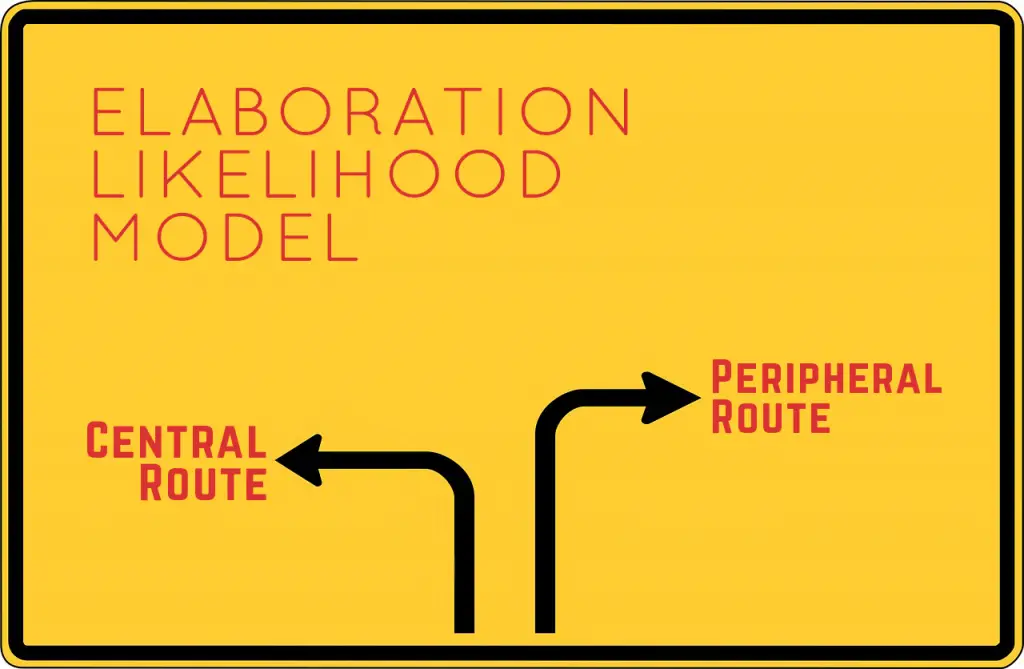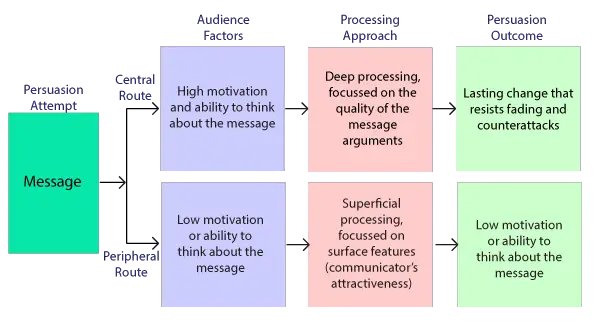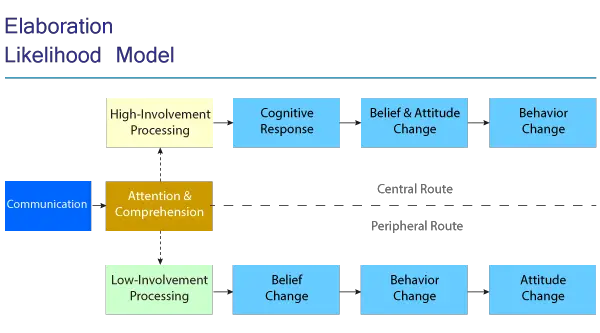Richard E. Petty and John T. Cacioppo made a theory based on the concept of persuasion in 1980 known as Elaboration Likelihood Model of Persuasion. This model is based on the idea that persuasion level of a message can affect the desired effect of the message. A persuasive message will most likely change the attitude of the message recipient. Attitude change occurs even when the intention of message sending is not to change the attitude of the recipient.
The theory is one of the two major models of persuasion along with Heuristic-Systematic Model. It came as an opposition to social judgment-involvement theory.
The theory is applied in the advertisement, marketing, media, and psychology.
Concept of Elaboration Likelihood Model of Persuasion
There are different kinds of people in the world. Many people accept whatever they are told or see. Trusting nature and gullible characteristics are also common in people. According to the creators of this model, these people who are gullible, trusting and believing, fall into one category.
In contrast to the type of people mentioned above, there is the second category of people who are skeptic, argumentative, opinionated and stubborn on their own beliefs. These types of people do not accept anything at face value but try to establish their thinking on others. They want others to notice what they have to say and believe in it. These people form their mindset through the facts they know to exist or think are true. Their perception of things and issues are firm and cannot be changed easily.
The third category of people who have firm beliefs but do not try to influence other’s thinking, especially due to their inability to convey the message in a way that can change the attitudes of others. They might be critical thinkers, but what they have to say is not taken by others to be important because their ability to express it in a convincing way is appalling.
Then there’s the fourth group of people who can create a balance between trusting others and also making others follow their thinking. They know which messages to trust and which ones to discard.
In short, the theory divides the people into four groups
- Gullible people who are easily influenced
- Skeptic, opinionated and argumentative people who cannot be easily influenced
- People with firm beliefs but with bad communication skills
- People who are leaders, who trust others as well as make others follow their thinking and ideas
These groups are taken as the psychological basis of the existence of persuasion. If gullible people are not there, there will be no one to persuade and if there is no person who has persuasive characteristics, then nobody will be able to persuade others.
But, these people won’t be able to conduct persuasion if there is no message. The message is a major factor as it must include something of persuasive value for persuasion to take its effect. The persuasive component should be something of interest for the message recipient or might add value to their own knowledge to change the attitude of the recipient.
Two Routes of Persuasion
Attitude change occurs in two ways according to the scholars who proposed the model. They are known as the two routes of persuasion. The two routes apply to and differ according to all the groups of people mentioned above. The two routes show that messages take one of the two routes during the process of sending and receiving messages.

Central Route Persuasion
Central route of persuasion tells that if a person gets to think about a message received for a longer duration of time, then the person has a greater chance of being persuaded. The process of thinking for a longer duration is known as elaboration.
For this, people need motivation. If the persuasion level of the message is strong, he/she gets persuaded to change their attitude or behavior.
There are certain features that message must have to be central route persuasive. They are:
- Persuasive communication
It has to be one-sided and not neutral. There must be some benefits to any of the people involved, either sender or receiver. For example, an advertisement. - Motivation to process
Relevant messages or deep relation with the topic of the message motivate people to change their attitude, which is also known as high involvement. They must really be gripped by the information and interested in it. - Ability to process
When there are distractions, complications and noise, people do not process the information they get. They might be hearing but not listening. This might cripple the persuasive power of the message. - Nature of arguments
If the message is strong, well constructed, convincing or creative, people will get the message better and change their attitude accordingly. This makes the recipient adopt the attitude changes.
Peripheral Route Persuasion
If a message given by a person does not elaborate on the meaning of the message, the message can still be persuasive even if the content is not persuasive enough. It can be due to direct relationship of the person with the content, familiarity with the topic, positive attitude towards the sender, positive thoughts (sex, money), etc. This kind of persuasion or attitude change might not last for a long time. This also happens if the recipient is unable to process the message or if the content is weak.
For example, if an energy drink is advertised by your favorite footballer, then you would like to buy that brand product rather than others.
Six features of peripheral route persuasion according to Robert Cialdini are:
- Reciprocation (past experience)
- Consistency (reliability since past)
- Social proof (Peer pressure)
- Liking (Attractiveness, personality)
- Authority (Power, expertise)
- Scarcity (Limited duration)
If by any of the two methods of persuasion, a person is affected, the person might have temporary or permanent attitude change. The effect lasts longer if the same message is repeated again and again.
Comparison of Peripheral and Central Route
The following images summarize the comparison between the central and peripheral routes:


